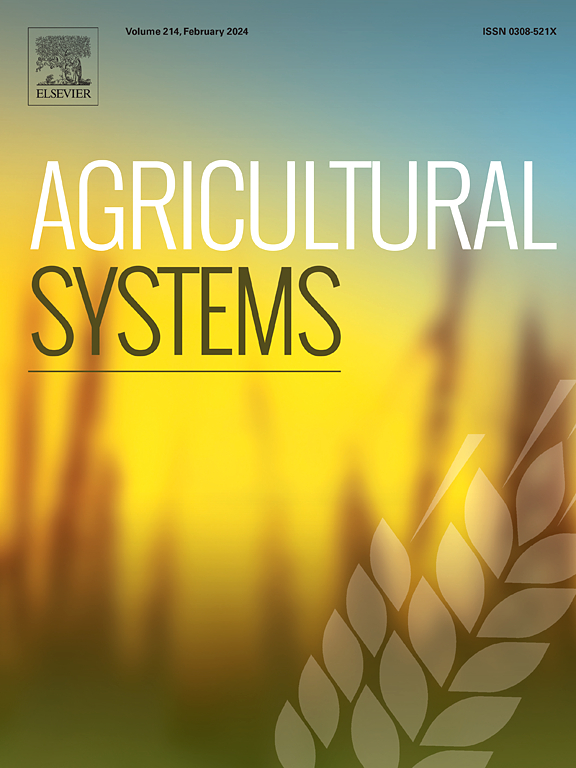Enhancing off-season maize production through tailored nitrogen management and advanced cultivar selection techniques
IF 6.1
1区 农林科学
Q1 AGRICULTURE, MULTIDISCIPLINARY
引用次数: 0
Abstract
Context
Climate change can trigger excessive rainfall, making mechanized soybean harvesting unfeasible. The off-season maize cultivation can benefit from soybean-maize rotation system, inoculated with Bradyrhizobium spp. strains, as a potential biological source of nitrogen (N). To meet the nutritional demand of maize crops, N fertilization management is essential. Recent research has sought to understand how maize cultivars respond to mineral N application.
Objective
In this work, we used a modern methodology to select maize cultivars with greater response to different application inputs of mineral N fertilizer, including N derived from soybean crop residues.
Methods
We used the Manhattan distance to verify the similarity between the responses of four maize cultivars (30F53VYHR, AG8700 PRO3, B2433PWU, and SYN7G17 TL) that were either unfertilized or fertilized with 40, 80, 120, and 160 kg N ha−1. The Technique for Order of Preference by Similarity to the Ideal Solution method was applied to select the most responsive cultivar.
Results and conclusions
Among the four maize cultivars, SYN7G17TL and AG8700PRO3 are more responsive to N fertilizer application in medium and high-fertility agricultural soils, respectively. When soil fertility levels are disregarded, the AG8700PRO3 cultivar has greater potential response to N fertilization, agreeing with previous studies.
Significance
The proposed approach is easy to use and adapt and provides an appropriate mechanism for selecting maize cultivars sown in areas with soybean residues, thus contributing to more sustainable planting as it adequately assesses nitrogen management.

通过量身定制的氮肥管理和先进的品种选择技术提高玉米淡季产量
气候变化可能引发过度降雨,使机械化大豆收割变得不可行。接种缓生根瘤菌的大豆-玉米轮作系统可作为玉米作物潜在的氮素生物来源。为满足玉米作物的营养需求,氮肥管理是至关重要的。最近的研究试图了解玉米品种对矿质氮施用的反应。目的采用现代方法筛选对矿质氮肥(包括大豆作物残茬氮肥)响应较大的玉米品种。方法利用曼哈顿距离(Manhattan distance)对未施肥和施肥40、80、120和160 kg N ha−1的4个玉米品种(30F53VYHR、AG8700 PRO3、B2433PWU和SYN7G17 TL)的响应进行相似性验证。采用与理想溶液法相似的优先排序技术,筛选最具响应性的品种。结果与结论4个玉米品种中,SYN7G17TL和AG8700PRO3在中肥力和高肥力农业土壤中对氮肥的响应最大。在不考虑土壤肥力水平的情况下,AG8700PRO3品种对氮肥的潜在响应更大,与前人研究一致。意义该方法易于使用和适应,为大豆残茬地区玉米品种的选择提供了一种合适的机制,并充分评估了氮素管理,有助于提高种植的可持续性。
本文章由计算机程序翻译,如有差异,请以英文原文为准。
求助全文
约1分钟内获得全文
求助全文
来源期刊

Agricultural Systems
农林科学-农业综合
CiteScore
13.30
自引率
7.60%
发文量
174
审稿时长
30 days
期刊介绍:
Agricultural Systems is an international journal that deals with interactions - among the components of agricultural systems, among hierarchical levels of agricultural systems, between agricultural and other land use systems, and between agricultural systems and their natural, social and economic environments.
The scope includes the development and application of systems analysis methodologies in the following areas:
Systems approaches in the sustainable intensification of agriculture; pathways for sustainable intensification; crop-livestock integration; farm-level resource allocation; quantification of benefits and trade-offs at farm to landscape levels; integrative, participatory and dynamic modelling approaches for qualitative and quantitative assessments of agricultural systems and decision making;
The interactions between agricultural and non-agricultural landscapes; the multiple services of agricultural systems; food security and the environment;
Global change and adaptation science; transformational adaptations as driven by changes in climate, policy, values and attitudes influencing the design of farming systems;
Development and application of farming systems design tools and methods for impact, scenario and case study analysis; managing the complexities of dynamic agricultural systems; innovation systems and multi stakeholder arrangements that support or promote change and (or) inform policy decisions.
 求助内容:
求助内容: 应助结果提醒方式:
应助结果提醒方式:


